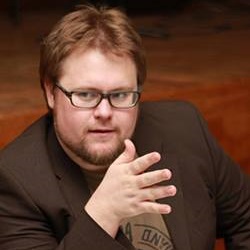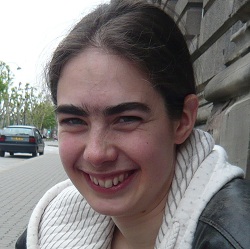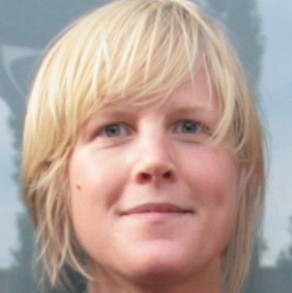Former PhD students and Postdocs

Belen C. Garcia |

Sebastian Sten |

Markus Karlsson |

Natasha M. Drissi |

Rikard Johansson |

Mikael Forsgren |

Karin Lundengård |

Elin Nyman |

Cecilia Brännmark |
Former MSc students
| Name | Project description |
|---|---|
| Sophia Cedermalm & Erik Sars |
Sophia and Erik thesis work revolved around biomechanical modeling, they developed our Digital Twin to include movements. Their work is titled Performing Professional Dance with a Biomechanical Model of a Human Body. |
| Arphita Honnal Venkatesh | Arphita's work revolved around mathematical modelling of cortisole response to exercise. Her work is titled Mathematical Modelling Of Cortisol Response To Exercise. |
| Sofia Gyulai |
Sofia did her Master Thesis in our group during the autumn of 2021 until early spring 2022. Her work, Integration of Digital Twin Technology and Health Dialogues: An Interface Design to Contribute to Motivation for Healthy Habits, were focused around developing a user interface for the Digital twin to be used connected to the "Health conversation" (Hälsosamtalet) to increase motivation and thus, leading to better preventive care. |
| Henrik Podéus |
Henrik did his Master thesis project revolving around our modelling of the brain during 2021. The thesis is titled Neural response of a Neuron population: A mathematical modelling approach. |
| Kajsa Tunedal |
Kajsa Tunedal did her master thesis in the group during 2021, focusing on fatty acid metabolism. The thesis is titled Mathematical modeling of fatty acid metabolism during consecutive meals and fasting: New insights into fatty acid regulation based on arterio-venous data. |
| Gustav Magnusson |
Gustav did his MSc thesis jointly between Chalmers University and our group, during 2020, developing a new framework for creating mathematichal models. His thesis is titled Mathematical modelling of the human physiology - Developing a new framework for creating mathematical models adapted to the digital twin project and modelling the neurovascular coupling. |
| Jonatan Baggman |
Jonatan did his master thesis during 2020, looking into imputations for medical datasets and how to use them for machine learning. The machine learning models will hopefully be used in combination with mechanistic systems biology models to predict the risk of different diseases. |
| Simon Wu |
Simon did his MSc thesis in our group durin 2019 and focused on describing the association between chronic inflammation and the development of type 2 diabetes (T2D). The thesis is titled Mathematical Modelling of Insulin Resistance Development Caused by Chronic Inflammation. |
| Ellen Lesshammar |
During 2018 Ellen did her MSc thesis work with us, the project was titled ‘Mathematical modelling of TLR4-activatedmacrophages in inflammation’. |
| Nicolas Sundqvist |
During Nicolas's MSc thesis, in 2018, a model for the central human metabolism was created and evaluated with regards to the model’s ability to predict a validation dataset. The thesis is titled Can you trust your model? A showcase study of validation in 13C metabolic flux analysis. |
| Christian Simonsson |
Christan did his MSc thesis with us 2018, focusing on short-term adiponectin secretion from white adipocytes. The thesis is titled Mathematical modeling of adrenaline-induced adiponectin secretion in white adipocytes. |
| Victor Viberg |
Victor's MSc thesis, perfomed during 2018, aimed to describe metabolic fluxes in cancer metabolism. The thesis is titled Quantifying metabolic fluxes using mathematical modeling. |
| Fredrick Eklund |
In 2017, Fredrick did his MSc thesis with us, focusing on developing a tool for Cardiovascular disease (CVD) prediction. The thesis is titled “Guided Bayesian Graphical Network model for Cardiovascular Disease Prediction”. |
| Niclas Bergqvist |
Niclas Bergqvist did his master in the group in 2017 on multi-level multi-scale modeling of the insulin signaling pathway in rat adipocytes. The thesis is titled A systems biology analysis connects insulin receptor signaling with glucose transporter translocation in rat adipocytes. |
| Theodor Erngren |
Theodor's MSc thesis, that he did during 2017, describing how inhaled particles are deposited in the lungs. The thesis is titled DEVELOPING COMPUTATIONAL METHODS TOPREDICT THE FATE OF INHALED PARTICLES IN THELUNG. |
| William Lövfors |
William Lövfors worked on his Msc thesis in our group during 2016, developing a mechanistic model of the entire phosphoproteome. The thesis is titled A first phosphoproteome-wide mechanistic model of insulin signaling. |
| Hao Li |
Hao Li did his master thesis in the group during 2016 aiming for a deeper understanding of the insulin control of blood glucose. The thesis is titled Multi-level multi-scaled metabolites simulation. |
| Rebecca Melin Rydfalk |
Rebecca did her MSc thesis with us 2015. Her work focused on the ucp1 protein and how it contributes to the function of beige adipocyte. |
| Martin Golvvik |
Martin Gollvik wrote his master's thesis in our group during 2014. Exploring the potential use of metamodeling in liver MRI diagnosis. The thesis is titled Metamodeling for ultra-fast parameter estimation: Theory and evaluation of use in real-time diagnosis of diffuse liver disease. |
| Vasileios Athanasiou |
Vasileios Athanasiou did his master thesis in the group during 2014 and worked on modelling of the fMRI BOLD response. The thesis is titled Estimation and modelling of fMRI BOLD response. |
| Linnea Bergenholm |
In Linnea's MSc thesis work, 2013, a bolus calculator was developed to predict the changes in blood glucose (BG) levels following different external factors. The thesis is titled Modeling as a Tool to Support Self-Management of Type 1 Diabetes. |
| David Janzén |
In David's MSc thesis work, during 2012, the distribution of the transport rate in S. cerevisiae was studied by using a mathematical modelling approach. The thesis is titled Standard two-stage and Nonlinear mixed effect modelling for determination of cell-to-cell variation of transport parameters in Saccharomyces cerevisiae. |
| Mikael Fredrick Forsgren |
Mikael's MSc thesis work, during 2011, aimed to combine the two fields of Systems Biology and Magnetic resonance imaging (MRI). The thesis is titled Human Whole Body Pharmacokinetic Minimal Model for the Liver Specific Contrast Agent Gd-EOB-DTPA. |
| Karin Lundengård |
Karin's MSc thesis work, during 2011, resulted in a model describing the desensitisation/resensitisation interplay of the β-adrenergic receptor signaling pathway of the healthy adult heart. The thesis is titled De- and Resensitisation of Cardiac β-Adrenergic Receptor Signaling: A Modelling Approach. |
| Linnea Järvstråt |
Linnea Järvstråt did her Master thesis in our group during 2010 and 2011. In her project she worked with FRAP data, investigating cell-to-cell-variation between mother and daughter cells. The thesis is titled A New Third Compartment Significantly Improves Fit and Identifiability in a Model for Ace2p Distribution in Saccharomyces cerevisiae after Cytokinesis.. |
| Anton Höghäll |
Anton did his M.Sc. project in the spring of 2010. Evaluating algorithms for multimodal problems called metaheuristics. The thesis is titled Tuning of Metaheuristics for Systems Biology Applications. |
| Amanda Jonsson |
Amanda Jonsson did her M.Sc. project with us in 2009-2010, devoted to preliminary explorations of the potential of Baysian and boolean modelling. |
| Ulrike Münzner |
Ulrike Münzner did her Master thesis in our group during 2010. The thesis focused on FRAP data and determining parameter uncertainty for import/export parameters of nuclear shuttling dynamics. |
| Oscar Samuelsson |
Oscar Samuelsson did his M.Sc. project (2009-2010) devoted to the task of finding good evaluating procedures for the evaluation of optimization methods in the new prospect of identifying core predictions. The thesis is titled Benchmarking Global Optimization Algorithms for Core Prediction Identification. |
| Eva-Maria Ekstrand |
Eva-Maria Ekstrand (formerly Hansson) did her master thesis with us in 2009. Her work involving downstream signalling, and the mechanistic machinery leading to the cellular insulin resistance we see in Type 2 Diabetes. The thesis is titled Towards a mechanistic explanation of insulin resistance, which incorporates mTOR, autophagy, and mitochondrial dysfunction. |
| Fredrick Bäcklund |
Fredrik Bäcklund did his M.Sc. project with us in 2009 on the model-based study of the dynamics of serine phosphorylations in the IRS1 protein. |
| Peter Nyberg |
Peter Nyberg did his MSc thesis jointly with us during 2009. Exploring the identifability issue of parameters in models. The thesis is titled Evaluation of two Methods for Identifiability Testing. |
| Elin Nyman |
Elin's MSc thesis, presented 2009, incorperated an azoomable module for the fat tissue into a whole-body regulation model. The thesis is titled Hierarchical modeling of diabetes: a pilot study. |
Former Longterm Visitors
| Name | Project description |
|---|---|
| David Julleson |
David Julleson worked in our group between 2012 - 2014 and was involved in several of our publications on insulin signaling. David went on to take a PhD position in Synthetic Biology with Jens Nielsens group in Gothenburg. Here you can read more of his work. |
| Linnea Bergenholm |
Linnea Bergenholm worked in our group between 2012 - 2014 and was involved in one of our biggest publications on insulin signaling to date. Linnea continued as a Phd Student at Warwick University in collaboration with AstraZenica. The paper can be read here. |
| David Janzén |
David Janzén worked in our group between 2012 - 2014 with mixed effect modeling. During his stay in our group, David went for a internship in Boston for Merrimack Pharmaceuticals for 6 months before coming back to us to complete his thesis. After leaving our group, David is started his Phd-studies at Warwick University in collaboration with AstraZenica. The paper is available here. |
| Pelle Lundberg |
Pelle Lundberg worked in our group for over a year during 2010 and 2011. His main focus was on a collaboration with Jan Hasenhauer in Stuttgard (nowawdays Munich). In his project Pelle worked on a method to analytically evaluate and reject whole regions of the parameter space for systems biology models. |
| Eva-Maria Ekstrand |
Eva-Maria Ekstrand (formerly Hansson) did her master thesis with us in 2009. She then continued in our group for a longer project during 2010. During both projects, she worked with involving downstream signalling, and the mechanistic machinery leading to the cellular insulin resistance we see in Type 2 Diabetes. She then went on for a shorter project at MathCore Engineering AB. After that she did a traineeship in the Systems Biology company Merrimack Pharmaceuticals in Boston during spring 2011. After leaving our group, Eva-Maria went on to start her Phd at Linkoping University, working with bioreactors. The resulting paper is availble here. |
| Robert Palmér |
Robert Palmér worked with us for two years (2008-2010) on modelling of insulin signalling, and was an important part of finishing our JBC paper (Brännmark et al), and has also been involved in at least one more paper (Nyman et al), and has generally been an important part of the early formation of the group. Robert went on to work as a modelling consultant at MathCore Engineering AB. His work is availbe here. |
